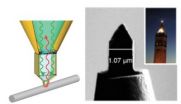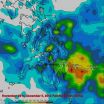(Press-News.org) SAN FRANCISCO, CA—December 6, 2012—Scientists at the Gladstone Institutes have identified a novel mechanism by which a type of low-carb, low-calorie diet—called a "ketogenic diet"—could delay the effects of aging. This fundamental discovery reveals how such a diet could slow the aging process and may one day allow scientists to better treat or prevent age-related diseases, including heart disease, Alzheimer's disease and many forms of cancer.
As the aging population continues to grow, age-related illnesses have become increasingly common. Already in the United States, nearly one in six people are over the age of 65. Heart disease continues to be the nation's number one killer, with cancer and Alzheimer's close behind. Such diseases place tremendous strain on patients, families and our healthcare system. But today, researchers in the laboratory of Gladstone Senior Investigator Eric Verdin, MD, have identified the role that a chemical compound in the human body plays in the aging process—and which may be key to new therapies for treating or preventing a variety of age-related diseases.
In the latest issue of the journal Science, available online today, Dr. Verdin and his team examined the role of the compound β-hydroxybutyrate (βOHB), a so-called "ketone body" that is produced during a prolonged low-calorie or ketogenic diet. While ketone bodies such as βOHB can be toxic when present at very high concentrations in people with diseases such as Type I diabetes, Dr. Verdin and colleagues found that at lower concentrations, βOHB helps protect cells from "oxidative stress"—which occurs as certain molecules build to toxic levels in the body and contributes to the aging process.
"Over the years, studies have found that restricting calories slows aging and increases longevity—however the mechanism of this effect has remained elusive" Dr. Verdin said. Dr. Verdin, the paper's senior author, directs the Center for HIV & Aging at Gladstone and is also a professor at the University of California, San Francisco, with which Gladstone is affiliated. "Here, we find that βOHB—the body's major source of energy during exercise or fasting—blocks a class of enzymes that would otherwise promote oxidative stress, thus protecting cells from aging."
Oxidative stress occurs as cells use oxygen to produce energy, but this activity also releases other potentially toxic molecules, known as free radicals. As cells age, they become less effective in clearing these free radicals—leading to cell damage, oxidative stress and the effects of aging.
However, Dr. Verdin and his team found that βOHB might actually help delay this process. In a series of laboratory experiments—first in human cells in a dish and then in tissues taken from mice—the team monitored the biochemical changes that occur when βOHB is administered during a chronic calorie-restricted diet. The researchers found that calorie restriction spurs βOHB production, which blocked the activity of a class of enzymes called histone deacetylases, or HDACs.
Normally HDACs keep a pair of genes, called Foxo3a and Mt2, switched off. But increased levels of βOHB block the HDACs from doing so, which by default activates the two genes. Once activated, these genes kick-start a process that helps cells resist oxidative stress. This discovery not only identifies a novel signaling role for βOHB, but it could also represent a way to slow the detrimental effects of aging in all cells of the body.
"This breakthrough also greatly advances our understanding of the underlying mechanism behind HDACs, which had already been known to be involved in aging and neurological disease," said Gladstone Investigator Katerina Akassoglou, PhD, an expert in neurological diseases and one of the paper's co-authors. "The findings could be relevant for a wide range of neurological conditions, such as Alzheimer's, Parkinson's, autism and traumatic brain injury—diseases that afflict millions and for which there are few treatment options."
"Identifying βOHB as a link between caloric restriction and protection from oxidative stress opens up a variety of new avenues to researchers for combating disease," said Tadahiro Shimazu, a Gladstone postdoctoral fellow and the paper's lead author. "In the future, we will continue to explore the role of βOHB—especially how it affects the body's other organs, such as the heart or brain—to confirm whether the compound's protective effects can be applied throughout the body."
INFORMATION:
Matthew Hirschey, PhD; John Newman, MD, PhD; Wenjuan He, PhD; Kotaro Shirakawa, PhD; Natacha Le Moan, PhD; Carrie Grueter, PhD; Hyungwook Lim, PhD; Laura Saunders, PhD; Robert V. Farese, Jr., MD; and Katerina Akassoglou, PhD, also participated in this research at Gladstone. This research was supported by the Gladstone Institutes.
About the Gladstone Institutes
Gladstone is an independent and nonprofit biomedical-research organization dedicated to accelerating the pace of scientific discovery and innovation to prevent, treat and cure cardiovascular, viral and neurological diseases. Gladstone is affiliated with the University of California, San Francisco.
Gladstone scientists discover novel mechanism by which calorie restriction influences longevity
Breakthrough suggests way to protect cells from damage caused by chronic disease
2012-12-07
ELSE PRESS RELEASES FROM THIS DATE:
Attitudes predict ability to follow post-treatment advice
2012-12-07
SAN ANTONIO, TX (December 6, 2012)—Women are more likely to follow experts' advice on how to reduce their risk of an important side effect of breast cancer surgery—like lymphedema—if they feel confident in their abilities and know how to manage stress, according to new research from Fox Chase Cancer Center to be presented at the 2012 CTRC-AACR San Antonio Breast Cancer Symposium on Saturday, December 8, 2012.
These findings suggest that clinicians must do more than just inform women of the ways they should change their behavior, says Suzanne M. Miller, PhD, Professor ...
Seeing in color at the nanoscale
2012-12-07
If nanoscience were television, we'd be in the 1950s. Although scientists can make and manipulate nanoscale objects with increasingly awesome control, they are limited to black-and-white imagery for examining those objects. Information about nanoscale chemistry and interactions with light—the atomic-microscopy equivalent to color—is tantalizingly out of reach to all but the most persistent researchers.
But that may all change with the introduction of a new microscopy tool from researchers at the Department of Energy (DOE)'s Lawrence Berkeley National Laboratory (Berkeley ...
Notre Dame research reveals migrating Great Lakes salmon carry contaminants upstream
2012-12-07
Be careful what you eat, says University of Notre Dame stream ecologist Gary Lamberti.
If you're catching and eating fish from a Lake Michigan tributary with a strong salmon run, the stream fish — brook trout, brown trout, panfish — may be contaminated by pollutants carried in by the salmon.
Research by Lamberti, professor and chair of biology, and his laboratory has revealed that salmon, as they travel upstream to spawn and die, carry industrial pollutants into Great Lakes streams and tributaries. The research was recently published in the journal Environmental Science ...
Silver nanocubes make super light absorbers
2012-12-07
DURHAM, N.C. -- Microscopic metallic cubes could unleash the enormous potential of metamaterials to absorb light, leading to more efficient and cost-effective large-area absorbers for sensors or solar cells, Duke University researchers have found.
Metamaterials are man-made materials that have properties often absent in natural materials. They are constructed to provide exquisite control over the properties of waves, such as light. Creating these materials for visible light is still a technological challenge that has traditionally been achieved by lithography, in which ...
NASA compiles Typhoon Bopha's Philippines Rainfall totals from space
2012-12-07
NASA's Tropical Rainfall Measuring Mission, or TRMM satellite can estimate rainfall rates from its orbit in space, and its data is also used to compile estimated rainfall totals. NASA just released an image showing those rainfall totals over the Philippines, where severe flooding killed several hundred people. Bopha is now a tropical storm in the South China Sea.
High winds, flooding and landslides from heavy rains with Typhoon Bopha have caused close to 300 deaths in the southern Philippines.
The TRMM satellite's primary mission is the measurement of rainfall in the ...
UC Davis study shows that treadmill testing can predict heart disease in women
2012-12-07
(SACRAMENTO, Calif.) — Although there is a widespread belief among physicians that the exercise treadmill test (ETT) is not reliable in evaluating the heart health of women, UC Davis researchers have found that the test can accurately predict coronary artery disease in women over the age of 65. They also found that two specific electrocardiogram (EKG) indicators of heart stress during an ETT further enhanced its predictive power.
Published in the December issue of The American Journal of Cardiology, the study can help guide cardiologists in making the treadmill test ...
TGen-US Oncology data guides treatment of metastatic triple-negative breast cancer patients
2012-12-07
PHOENIX, Ariz. — Dec. 6, 2012 — Genomic sequencing has revealed therapeutic drug targets for difficult-to-treat, metastatic triple-negative breast cancer (TNBC), according to an unprecedented study by the Translational Genomic Research Institute (TGen) and US Oncology Research.
The study is published by the journal Molecular Cancer Therapeutics and is currently available online.
By sequencing, or spelling out, the billions of letters contained in the genomes of 14 tumors from ethnically diverse metastatic TNBC patients, TGen and US Oncology Research investigators found ...
General thoracic surgeons emerge as leading providers of complex, noncardiac thoracic surgery
2012-12-07
While thoracic surgeons are traditionally known as the experts who perform heart surgeries, a UC Davis study has found that general thoracic surgeons, especially those at academic health centers, perform the vast majority of complex noncardiac operations, including surgeries of the esophagus and lungs.
The authors said their results, published in the October issue of The Annals of Thoracic Surgery, support the designation of general thoracic surgery as a distinct specialty, which will benefit patients when selecting surgeons for specific procedures.
"In years past, ...
Apollo's lunar dust data being restored
2012-12-07
Forty years after the last Apollo spacecraft launched, the science from those missions continues to shape our view of the moon. In one of the latest developments, readings from the Apollo 14 and 15 dust detectors have been restored by scientists with the National Space Science Data Center (NSSDC) at NASA's Goddard Space Flight Center in Greenbelt, Md.
"This is the first look at the fully calibrated, digital dust data from the Apollo 14 and 15 missions," said David Williams, a Goddard scientist and data specialist at NSSDC, NASA's permanent archive for space science mission ...
December 2012 Story Tips
2012-12-07
DISASTER RESPONSE – Limiting access . . .
Ensuring that only people who have legitimate business are allowed to enter areas hit by floods, hurricanes or other disasters is a big challenge, but Credentialing 2.0 offers a software solution. "Obviously, first responders, utility crews, tree cutters, disaster relief workers and members of the media have reasons to be on the scene, but there's no efficient way to control access," said Oak Ridge National Laboratory's David Resseguie, who leads the Credentialing 2.0 development team. The ORNL system helps officials to control ...
LAST 30 PRESS RELEASES:
American College of Cardiology comments on new dietary guidelines for Americans
American Society of Gene & Cell Therapy and Orphan Therapeutics Accelerator partner to advance and commercialize promising rare disease treatments
One in 14 patients having day case surgery have new or worse chronic pain 3 months after their operation
New study highlights link between eviction rates and gun violence
Heatwaves heat up soil but not toxin levels in rice, study finds
Digital modeling reveals where construction carbon emissions really come from
Turning farm waste into water filters
New study shows how the spleen helps the immune system accept a transplant
New Mayo Clinic study advances personalized prostate cancer education with an EHR-integrated AI agent
Researchers identify novel therapeutic target to improve recovery after nerve injury
Microbes in breast milk help populate infant gut microbiomes
Reprogramming immunity to rewrite the story of Type 1 diabetes
New tool narrows the search for ideal material structures
Artificial saliva containing sugarcane protein helps protect the teeth of patients with head and neck cancer
Understanding the role of linear ubiquitination in T-tubule biogenesis
Researchers identify urban atmosphere as primary reservoir of microplastics
World’s oldest arrow poison – 60,000-year-old traces reveal early advanced hunting techniques
Bristol scientists discover early sponges were soft
New study uncovers how rice viruses manipulate plant defenses to protect insect vectors
NSF–DOE Vera C. Rubin Observatory spots record-breaking asteroid in pre-survey observations
Ribosomal engineering creates “super-probiotic” bacteria
This self-powered eye tracker harnesses energy from blinking and is as comfortable as everyday glasses
Adverse prenatal exposures linked to higher rates of mental health issues, brain changes in adolescents
Restoring mitochondria shows promise for treating chronic nerve pain
Nature study identifies a molecular switch that controls transitions between single-celled and multicellular forms
USU chemists' CRISPR discovery could lead to single diagnostic test for COVID, flu, RSV
Early hominins from Morocco reveal an African lineage near the root of Homo sapiens
Small chimps, big risks: What chimps show us about our own behavior
We finally know how the most common types of planets are created
Thirty-year risk of cardiovascular disease among healthy women according to clinical thresholds of lipoprotein(a)
[Press-News.org] Gladstone scientists discover novel mechanism by which calorie restriction influences longevityBreakthrough suggests way to protect cells from damage caused by chronic disease




